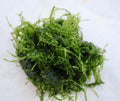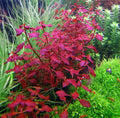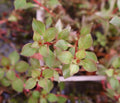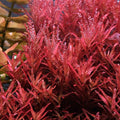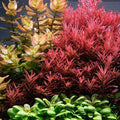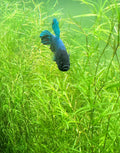Managing Algae in Bucephalandra Tanks
You want to replicate nature or recreate nature with your discipline and with your creativity and through art. Then do it in a way that you don't have to battle with algae, because you are most likely going to lose the battle.
Algae is a part of nature, and algae by itself is what you make it to be in a planted tank. It's neither good nor bad. Life develops with life.
If you want to provide your Buce plants with a healthy environment for them to thrive in, then the algae is going to do great in that environment as well. They feed from the same nutrients, and they metabolize pretty much the same—just that the algae are much simpler, so they grow at a really fast rate.
Algae is always present in every aquarium, in every planted tank, and in every fish tank for that matter. So the question here is, how to manage it?
1. Light
The number one thing that you have to look out for is your light. You need a strong light for your plants. Buce plants love strong light.
Don't focus that much on what algae likes and try to take that away from algae, because what algae likes is also what your plants like. And if you take that away from algae, you'll probably take that away from your plants as well.
That’s going to create just a massive bloom of algae and unwanted decomposition of your plants, and ultimately their death. So keep that in mind. Give them what they want. Give them what they need.
Usually anubias and some clips like the shade, or they like to be shaded, but if you supply them with the proper amount of lighting, they are going to be outstanding. The results are going to be much better.
And that's true with every plant. Even if they can grow in a low-light environment, if you supply them with a really good light, they are going to develop much better.
So that's the first thing to look out for: get a strong light.
It’s a little bit counterintuitive too, because if you research algae, it's related directly to light. But low light for your plants is going to limit the intake of nutrients that they can photosynthesize.
So it's really important to have the ability to dim your light when you start a tank and then be able to ramp it up as the tank grows and matures and as your plants adapt.
You just need the low light when they are in that state of shock.
2. Plant Adjustment
One important thing that you have to take into consideration is that Buce plants need some time to adjust, and they need some time to adapt to their new environment.
When you disturb them, they get shocked. They stay in a state of shock. They are not taking nutrients in. They are not growing as much. They are just trying to enable themselves to live in this environment and practically changing their diet.
So algae exists for a reason, and it's for the nutrient export of excess nutrients in the water.
If you have a lot of nitrogen and a lot of phosphorus in the water and your plants are shocked, then it will develop. It will thrive because your plants are not taking in any nutrients, and they are decomposing themselves.
Plants, when they are not happy in a spot, are likely to lose their leaves. Or when they need to adapt to a new environment, they're going to lose their leaves or shed their leaves. And then they're going to grow new leaves that are adapted to that new environment.
So if the new environment is great, the plants will do great in no time.
If you don't address the issue, then the algae most likely is going to take over, and there is nothing you can do about it. You are just going to wake up one day, and it's going to be just filled with algae. It's that fast. Sometimes just a couple of days and a tank may be filled.
3. CO₂
CO₂ is the most difficult one to dial, but it is the most important one as well. If you don't have a good saturation of CO₂, a continuous and constant saturation of CO₂, you're going to stress your plants out.
And what does this stress result in? An excess of nutrients in the water. So the algae is going to take advantage of that, and it's going to bloom.
You have to turn it on four hours before the lights turn on. And if you have some ambient light before, three or four hours before, that ambient lighting is going to hit your tank.
If you don't do that, the light that reaches the tank before your tank lights turn on is going to feed the algae, and they are going to have an advantage of several hours a day of photosynthesis and nutrients before your plants are even able to start their photoperiod.
You need to keep the saturation of CO₂ high so that your plants are always ready to get that nutrient intake quickly when the lights turn on.
4. Flow
Flow is a tricky one—not as much as CO₂, but still really tricky. You can see if your flow is enough by putting your CO₂ right below the outtake of your canister or your filter and looking at the bubbles and how they move around your tank.
If you can see that bubbles are reaching every inch of your tank, then you're doing it okay. But if you can see that it's not, then it's not a flow.
A flow movement is more like turbulence. If it's really turbulent, then you're doing something wrong. You have overflow. On the other side, you might have some minor mistakes with the nutrients, and you might get away with it for a while. But if you don't correct those mistakes, it can get out of hand as well.
So try to get your tests out when you dose—in the mornings, midday, or at night. Whatever your dose, just try to dose before and after the photoperiod of your Buce plants so you can deduce how much they are consuming.
If you deduct how much they are consuming, you're going to be able to dose wisely and not overdose, because that's another issue that you might face when dealing with planting.
In the aquascaping hobby, the reality is that you have to do what works for you. You have to have the Buce plants that you love, because you're the only one that's going to see them, maintain them, trim them, etc.



